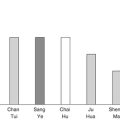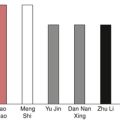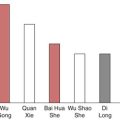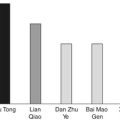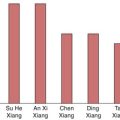Chapter Four. Herbs that drain downwards
 |
1. What are the functions of and indications for downward-draining herbs?
Herbs that drain downwards are able to stimulate the intestine, purge accumulation and guide out stagnation, eliminate toxic substances, drain Fire or Cold, and drive out water. These herbs are used in the following conditions.
Constipation
Constipation can be divided into Deficiency and Excess types, which are often caused by insufficient fluid in the intestines or obstruction of the Qi with Heat or Cold. It is often related to bad dietary habits, changes of diet, usage of certain medicines, weakness of the Yin and Blood in elderly people, after giving birth, or it may be habitual constipation. The main symptoms are constipation or difficult bowel movement, abdominal distension, fullness of the stomach and dryness in the mouth. The tongue is slightly purple; the coating is dry, thick, white or yellow in color. The pulse is deep, wiry or deep and thready.
Obstruction in the intestines
The obstruction often has an acute onset. It can be caused by accumulation of feces, Qi, Blood, Heat, Fire-toxin or Cold in the intestine as well as in the abdomen. The main symptoms are severe abdominal pain, cramp, distension, irregular bowel movement or no bowel movement, fullness of the stomach, nausea, vomiting, reduced appetite, dryness in the mouth, thirst and irritability. The tongue body is red with a dry, yellow or white coating and the pulse is deep, slippery and wiry. This syndrome can be seen in severe constipation, initial stages of simple or partial intestinal obstruction, intestinal adhesion, intussusception and other acute abdominal syndromes.
Fire-toxin accumulation
In the syndrome of Fire-toxin accumulation, when the Fire-toxin has not yet accumulated over a long time and the Blood is not strongly disturbed, the main symptoms are fever, irritability, severe thirst, pain and distension in the abdomen (such as in the initial stage of acute appendicitis), acute pancreatitis, acute cholecystitis, hepatitis and ulcer perforation with mild infection and inflammation. Most of the herbs to treat this disorder are cold in temperature. They can purge the accumulation, drain Excessive-Heat and cool the Blood. They are often used to treat Fire-toxin accumulation in the body. The downward-draining action can move the bowels, and can therefore eliminate Heat and Fire-toxin from the body.
Water accumulation
When the water metabolism is disturbed, water can accumulate in certain places; this is seen in hydrothorax and ascites. This disorder brings about symptoms such as tightness in the chest, shortness of breath and distension of the abdomen. It can also relieve generalized edema. There are herbs which have both cathartic and diuretic effects and can drive out the water and relieve the symptoms.
2. What are the characteristics of downward-draining herbs?
Herbs that drain downwards are able to stimulate the intestines and purge obstructions and Fire-toxins, as well as drive out water. They have the following characteristics in their properties and functions.
Bitter and cold
Most of the herbs that drain downward are bitter and cold because most of the syndromes they treat have substantial accumulation with Excessive-Heat in the intestines. The Heat comes from various sources. First of all, the Stomach and Large Intestine are called the ‘family of Bright Yang (Yang Ming)’ where Yang and Qi are abundant. Secondly, the Stomach and Large Intestine are the most important organs for transporting food and feces, so the Yang and Qi are active all the time and also produce heat. Thirdly, when there is obstruction in the intestines, as in constipation, the Qi is easily obstructed and Heat will be produced; moreover, most infections produce Heat or Fire-toxin and the accumulation of toxic substances also produces heat when the functions of the liver and kidney are impaired.
Bitterness and Cold both move downwards; Cold, of course, can drain Heat and Fire-toxin. The commonly used bitter and cold herbs are Da Huang ( Rhei rhizoma), Lu Hui ( Aloe folii extractus), Qian Niu Zi ( Pharbitidis semen)*, Gan Sui ( Euphorbiae kansui radix)*,  ( Knoxiae radix)*, Shang Lu ( Phytolaccae radix)* and Ting Li Zi ( Lepidii/Descurainiae semen).
( Knoxiae radix)*, Shang Lu ( Phytolaccae radix)* and Ting Li Zi ( Lepidii/Descurainiae semen).
 ( Knoxiae radix)*, Shang Lu ( Phytolaccae radix)* and Ting Li Zi ( Lepidii/Descurainiae semen).
( Knoxiae radix)*, Shang Lu ( Phytolaccae radix)* and Ting Li Zi ( Lepidii/Descurainiae semen).Salty and cold
Herbs with a salty taste move downwards; they are also able to generate the Body Fluids and soften hardness. A downward-draining substance with a salty and cold property is especially suitable for treating constipation when the feces are very dry and hard. An example is Mang Xiao ( Natrii sulfas).
Sweet
Herbs with a sweet taste are normally seen among the moist laxatives. Sweetness can harmonize the functions of the intestines and alleviate cramp; examples include Huo Ma Ren ( Cannabis semen) and Yu Li Ren ( Pruni semen). Where harsh purgatives or herbs that drive out water possess a sweet taste, this may relatively reduce the speed of the action and reduce the harsh property. Herbs with this characteristic include Fan Xie Ye ( Sennae folium) and Huo Ma Ren.
Seeds or nuts
Seeds or nuts are gentle laxatives. As they contain lipids, they can lubricate the intestines and ease the expulsion of stools. They are especially suitable for habitual constipation and constipation caused by weakness of Yin and Blood. Commonly used herbs are Huo Ma Ren, Yu Li Ren, Xing Ren ( Armeniacae semen) and Tao Ren ( Persicae semen).
Entering the Stomach and Large Intestine meridians, or Spleen, Lung and Kidney meridians
Purgatives mainly enter the Stomach and Large Intestine meridians where their actions are focused; the herbs that drive out water enter the Lung, Spleen and Kidney meridians, which mainly influence the water metabolism. They are not only able to empty the bowels, but also to drive out water by diuretic action.
Other ways of administration
In order to achieve a good effect of purging the accumulation of or eliminating the toxic substances, herbs that drain downward are used not only orally, but also often in an enema.
3. What are the precautions and contraindications for the use of herbs that drain downwards?
First of all, herbs that drain downwards are harsh herbs; their functions are strong and their speed is high, so they may easily injure the Stomach-Qi and Body Fluids. Moreover, many of them are also poisonous. Compared with other moist laxatives, they should only be taken for a short treatment period and their dosage should be controlled carefully. When the severe symptoms have disappeared, these herbs should be stopped immediately. Long-term usage of the purgatives for constipation may lead to consumption of the Body Fluids in the intestines and make the constipation worse. Since the actions of these herbs are harsh, they are used only for Excessive syndromes and for people with a strong constitution. They are not suitable for people with a weak constitution or chronic diseases. For patients who suffer from Deficiency syndromes but also need these herbs in the treatment of acute or severe accumulation, such as in uremia, these herbs must be used in combination with the tonifying herbs.
Secondly, downward-draining herbs can drain Qi as well as Blood downwards, so they are also not suitable for use during menstruation or in bleeding conditions. They are also contraindicated in pregnancy.
Thirdly, herbs that drain downwards are, in principle, not suitable for patients with Exterior syndromes. It is better to treat the Exterior first and not to drain downwards. Otherwise, the exogenous factors may be led deeper into the body.
When downward-draining herbs are used to treat acute abdominal syndromes, such as acute intestinal obstruction, appendicitis, cholecystitis and pancreatitis, it is also important to remember that these herbs are suitable only for certain periods in the whole pathological process of the disease, or in certain types of disorder. These herbs should only be prescribed by doctors after Western medical examination. If the results of the herbal treatment are not satisfactory, an operation is usually indicated.
4. What are the characteristics of Da Huang ( Rhei rhizoma), Mang Xiao ( Natrii sulfas), Fan Xie Ye ( Sennae folium) and Lu Hui ( Aloe folii extractus) as purgatives?
These four substances are cold in nature and are commonly used as purgatives. They can be used together or separately according to clinical need.
Da Huang is very bitter and cold and it stimulates the intestines intensively; therefore it can strongly drain Heat and move the stools. It is the most important herb for treating Excessive-Heat accumulation in the intestines and Qi obstruction by the feces. Da Huang can be prescribed when there is high fever, profuse sweating, thirst, constipation, abdominal pain and distension. The patient has a red tongue with a dry, yellow coating and a slippery, wiry and rapid pulse. In clinical practice, it can be used for constipation, irritable bowel syndrome and the primary stage of acute abdominal syndromes.
Mang Xiao has a less strong action in stimulating the intestine, moving stools and draining Heat than Da Huang because it is not as bitter and cold as Da Huang. Mang Xiao characteristically moistens the intestine, softens feces and promotes bowel movement because it is a salty and cold substance. It is particularly suitable for constipation when the feces are very dry and hard.
Da Huang and Mang Xiao are often used together to treat constipation and Excessive-Heat in the intestine. Because Da Huang can purge the bowel and Mang Xiao can soften the feces, they can accentuate each other’s therapeutic actions.
Fan Xie Ye is sweet, bitter and cold and enters the Large Intestine meridian. It is moist in nature and is able to moisten Dryness in the Large Intestine, clear Heat and promote bowel movement. The effect of moving the bowels is stronger than that of Da Huang. If a small dosage of Fan Xie Ye is applied, it can also promote the digestion and is used for constipation caused by a bad diet. In clinical practice, it is often used alone as a purgative.
Lu Hui is very bitter and cold and enters the Liver, Heart, Stomach and Large Intestine meridians. It is a very strong herb for purging the bowels and reducing Excessive-Heat. It characteristically drains Liver-Fire and Heart-Fire when Heat has been transported to the Stomach and Large Intestine. Symptoms of this condition include irritability, anxiety, insomnia, a bitter taste in the mouth, thirst and constipation. As its smell is very unpleasant, it is mainly taken in pills instead of in a decoction.
5. What are the characteristics of Da Huang ( Rhei rhizoma)? What are the differences between the products of this herb?
Da Huang is a commonly used herb in clinical practice. It is a very good purgative agent compared with those in Western medicine. It stimulates the intestines and purges the bowels without severe cramp. Its purgative effect appears 6 hours after taking the herb; Da Huang enema brings a much quicker onset of action.
Da Huang is often used not only as a purgative agent, but also as an agent to relieve toxicity. It can guide out Heat, Damp-Heat or Fire-toxin through the bowels. It can also cool the Blood, invigorate its circulation and eliminate congealed Blood, so it is often used in different kinds of infection, which are considered as a process of Fire-toxin produced in the intestines or in the abdomen. It can also be used for accumulation of toxic substances when the functions of the Liver and Kidney are impaired. Its decoction can also be used as an enema in order to eliminate Fire-toxin in the body.
Da Huang can be used raw or processed. The raw form has a stronger function of purging accumulations in the intestines than the baked form. The raw form should not be cooked for too long, otherwise its purgative action becomes weaker. When Da Huang is fried with alcohol, it is more effective for clearing Excessive-Heat in the Upper Jiao and treating headache, toothache and infection of the eyes. The charcoal of Da Huang has a better effect in stopping bleeding and eliminating congealed Blood.
6. What are the differences between the products of Mang Xiao ( Natrii sulfas)?
Mang Xiao is a commonly used purgative substance. Since it is salty and cold and can moisten the intestines and soften the stools, it is often used together with Da Huang ( Rhei rhizoma) to treat constipation.
The main constituent of Mang Xiao is sodium sulfate. The intestines cannot absorb sulfate, so it stays in the intestines and increases osmotic pressure to return the water in the intestine, stimulate it and soften the feces.
The regularly used product is called Mang Xiao. The impure form of Mang Xiao is called Pu Xiao; it contains salt, calcium sulfate and magnesium sulfate as well as sodium sulfate. Its purgative action is stronger than that of Mang Xiao. Mirabilitum purum is called Xuan Ming Fen or Yuan Ming Fen and it is less effective in its purgative action compared with Mang Xiao, but is more effective for topical application to treat stomatitis.
7. What are the differences between Huo Ma Ren ( Cannabis semen), Yu Li Ren ( Pruni semen), Xing Ren ( Armeniacae semen), Tao Ren ( Persicae semen) and Hei Zhi Ma ( Sesami semen nigricum) in their laxative effects?
Because all of these seeds or nuts contain lipids, they have the function of moistening the stools and lubricating the intestines and so are able to treat constipation. They also have different characteristics and can be used in different conditions.
Huo Ma Ren is a sweet and neutral herb; it can either promote bowel movement or tonify the Qi and Blood. It is particularly suitable for treating constipation after surgery, giving birth, or in patients who are also suffering from chronic diseases or have a weak constitution. It can also be used to treat hemorrhoids and habitual constipation.
Xing Ren, Tao Ren and Hei Zhi Ma usually are not used as laxatives, but they have the function of moistening the intestines and promoting bowel movement. Xin Ren enters the Lung meridian which is externally–internally related to the Large Intestine meridian, and it is especially used to treat disturbance of the dispersing and descending function of the Lung-Qi that influences the intestines and causes constipation, and vice versa. Tao Ren enters the Lower Jiao, can break up congealed Blood and is more suitable for constipation with signs of Blood stagnation in the intestines, such as in infections, acute abdominal syndromes and hemorrhoids. Hei Zhi Ma is able to nourish the Yin, Essence and Blood and has similar effects to Huo Ma Ren, but the tonifying action is stronger and the action of moving the bowel is weaker than that of Huo Ma Ren.
8. What are the characteristics of Gan Sui ( Euphorbiae kansui radix)*,  ( Knoxiae radix)* and Yuan Hua ( Genkwa flos)*
( Knoxiae radix)* and Yuan Hua ( Genkwa flos)*
These three herbs are all violent cathartic as well as diuretic herbs. They can drain water and drive out congealed fluids by causing diarrhea and promoting urination. They are used only in severe generalized edema or accumulation of fluids in the thoracic or abdominal cavities. According to early studies and experiences, these three herbs are considered incompatible with Gan Cao ( Glycyrrhizae radix).
The three herbs are often used together, but each has its own characteristics. Gan Sui has the strongest cathartic effect and Yuan Hua has the weakest effect of the three herbs. However, Yuan Hua is the most poisonous herb of the three and Gan Sui is the weakest. Gan Sui particularly drives out the fluid from the meridians,  drives out the fluid from the internal organs and Yuan Hua from the joints and cavities.
drives out the fluid from the internal organs and Yuan Hua from the joints and cavities.
 drives out the fluid from the internal organs and Yuan Hua from the joints and cavities.
drives out the fluid from the internal organs and Yuan Hua from the joints and cavities.Comparisons of strength and temperature in herbs that drain downwards
 |
| Fig. 4.1. |
| Comparison of the strength of the downward-draining herbs. Gan Sui ( Euphorbiae kansui radix)*,  ( Knoxiae radix)*, Qian Niu Zi ( Pharbitidis semen)*, Yuan Hua ( Genkwa flos)*, Fan Xie Ye ( Sennae folium), Lu Hui ( Aloe folii extractus), Da Huang ( Rhei rhizoma), Mang Xiao ( Natrii sulfas), Huo Ma Ren ( Cannabis semen), Yu Li Ren ( Pruni semen). ( Knoxiae radix)*, Qian Niu Zi ( Pharbitidis semen)*, Yuan Hua ( Genkwa flos)*, Fan Xie Ye ( Sennae folium), Lu Hui ( Aloe folii extractus), Da Huang ( Rhei rhizoma), Mang Xiao ( Natrii sulfas), Huo Ma Ren ( Cannabis semen), Yu Li Ren ( Pruni semen). |
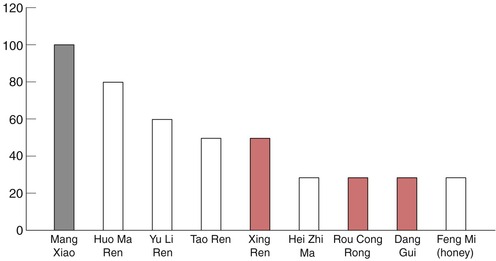 |
| Fig. 4.2. |
| Comparison of the herbs that moisten the intestines and promote bowel movement. Mang Xiao ( Natrii sulfas), Huo Ma Ren ( Cannabis semen), Yu Li Ren ( Pruni semen), Tao Ren ( Persicae semen), Xing Ren ( Armeniacae semen), Hei Zhi Ma ( Sesami semen nigricum), Rou Cong Rong ( Cistanchis herba)**, Dang Gui ( Angelicae sinensis radix), Feng Mi ( Mel). |
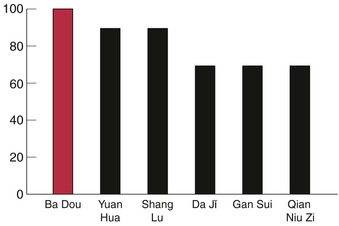 |
| Fig. 4.3. |
| Comparison of the toxicity of the downward-draining herbs. Ba Dou ( Crotonis fructus)*, Yuan Hua ( Genkwa flos)*, Shang Lu ( Phytolaccae radix)*,  ( Knoxiae radix)*, Gan Sui ( Euphorbiae kansui radix)*, Qian Niu Zi ( Pharbitidis semen)*. ( Knoxiae radix)*, Gan Sui ( Euphorbiae kansui radix)*, Qian Niu Zi ( Pharbitidis semen)*. |

